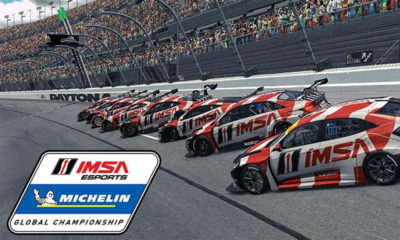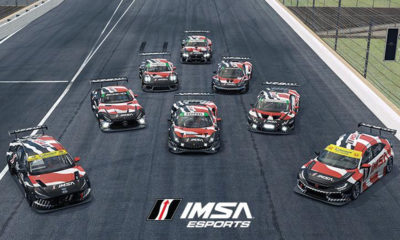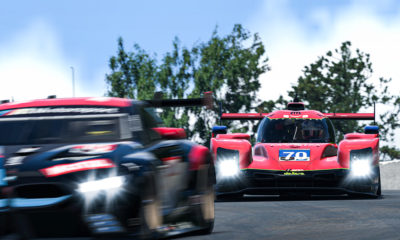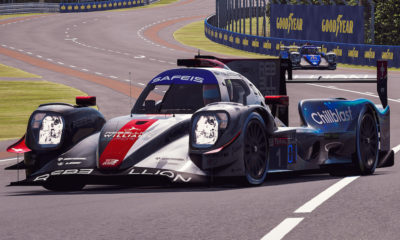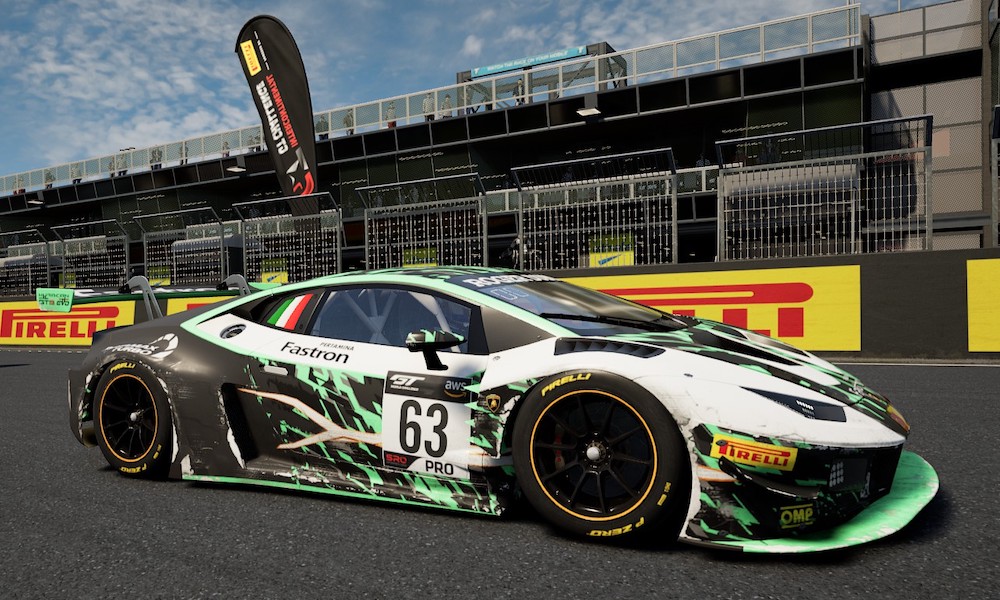
Image: Lamborghini
The coronavirus pandemic accelerated interest in esports as real-world racing closed off for a third of the year.
While most sports struggled to captivate their audiences in the absence of real-world competition, motorsport harnessed the sim racing industry’s years of development to create huge opportunities as audiences starved of live racing flocked to well-run virtual events.
Manufacturers also got involved and helped to spread the word with official factory drivers popping up in championships licensed by the major sports car sanctioning bodies.
BMW, for instance, used its real-world race strategists to call its IMSA iRacing Pro Series efforts. This tactic set the precedent for what teams needed to do to fare well in June’s virtual 24 Hours of Le Mans, the pinnacle of the lockdown racing season.
While the motorsport downturn prompted some brands to assemble impromptu esports teams, others were better prepared having already set about cultivating sim racing programs and exploring ways of integrating these into their company structures for some time.
Lamborghini, for example, had already planned to launch its own one-make esports competition founded on the proven ‘gamer-to-racer’ philosophy this year, pandemic or not.
The Real Race was announced in May, right at the crest of the esports popularity wave.
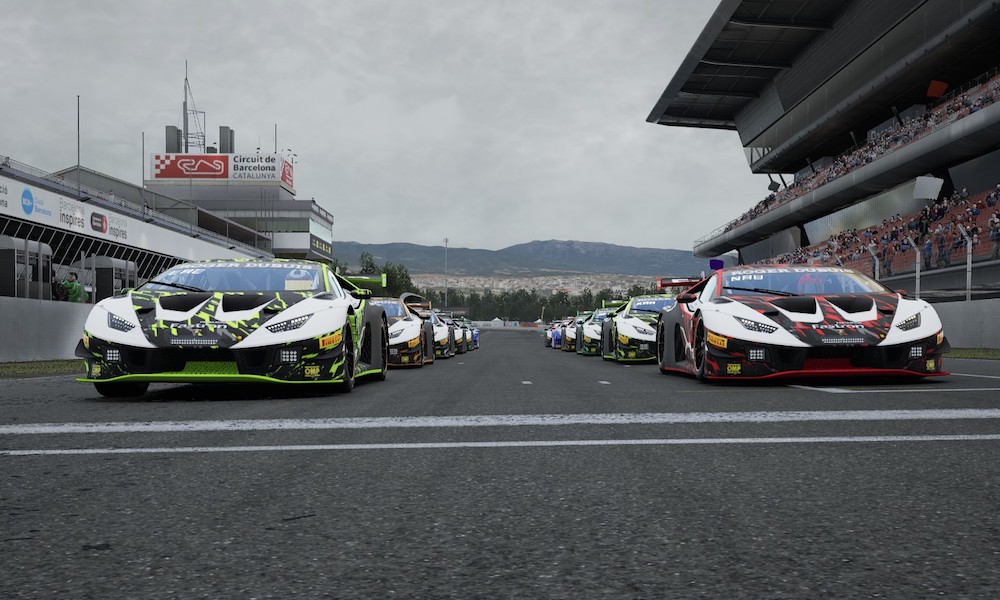
Image: Lamborghini
Origins of a New Opportunity
Lamborghini’s aim was to encourage at-home racers to enter a series of qualifying rounds, whittling the cohort down to an ultra-competitive Grand Final field and giving the ultimate top three the chance to drive a Lamborghini Super Trofeo Evo. All in four months.
Lamborghini’s head of brand marketing, Maurizio Grande, explains how offering a test as the prize was integral to closing the loop between real-world brand activities and esports.
“The idea behind it was that every moment of sim racing starts in reality before going to the digital world,” he says.
“This is because our eyes and brain are connected to the simulator, and the simulator is connected to the extension of our bodies through our hands.
“There are a lot of physical aspects, so the crossover between motorsport and virtual racing is very easy to understand.”
Lamborghini made sure to engage as many of its departments as possible to highlight the applicability of esports activation within a major automotive brand’s structure.
Its Squadra Corsa race department was closely linked to the running of the competition, while its Centro Stile design house created liveries for the Lamborghini Huracan GT3 Evos that were used for all of the races on Assetto Corsa Competizione.
This laid the foundations for a professional, serious and legitimate esports competition to commence.

Photo: Lamborghini
Down to Business
The route to deciding who would access the real-world Lamborghini test was intense.
Five qualifying rounds were held on Monza, Spa-Francorchamps, the Nürburgring, Suzuka and Laguna Seca, although participants didn’t need to enter all the races to reach the Grand Final.
Advancement to the final stage was earned by those finishing on the podium at Monza and Laguna Seca, and those finishing first and second at Spa, the Nürburgring and Suzuka.
The Grand Final itself was held on Sept. 24 and was accompanied by a full live presentation at Lamborghini’s Sant’Agata Bolognese headquarters involving quintuple 24 Hours of Le Mans winner Emanuele Pirro and 13-time Grand Prix winner David Coulthard.
Aggregate points scores were taken from a 30-minute contest at Barcelona and a 45-minute race at Bathurst to decide the ultimate top three.
Those who made the final found themselves in for a grueling few hours, with minimal rest time between finishing up at the tight and technical Circuit de Barcelona-Catalunya before plunging into the giddying undulations and punishing walls of Mount Panorama.
SRO E-Sport GT Series champion Nils Naujoks emerged as the man to beat: the 34-year-old Berlin-based Assetto Corsa Competizione expert dominated at Barcelona having already won the first public qualifier at Monza.
Also in the hunt were fellow qualifying race winners Kamil Pawlowski and Fulvio Barozzini who finished second and third in the Barcelona first leg, but nothing was decided heading into the longer Bathurst race.
High attrition was a major factor at Mount Panorama as only half the field finished on the lead lap in a brutal contest that featured excellent racing and plenty of rubbing.
Naujoks earned his spot at the real-world test with a bold late-race move for the win on Arnaud Lacombe at Griffins Bend after tracking the Frenchman down over the 23 laps.
Lacombe took damage after striking the wall and faded to seventh, enabling former US Formula 4 Championship competitor Jordan Sherratt to take second and bounce back from a ninth-place result at Barcelona to score a total of 20 points behind Naujoks’ 41.
Gianfranco Giglioli survived the Bathurst carnage to finish third, but when the aggregate scores played out it was the super-consistent Matthias Egger who produced a pair of fourth places to qualify for the real-world test alongside Naujoks and Sherratt.
Finalists decided, it was time to head to Italy for the virtual-to-real-world conversion moment.
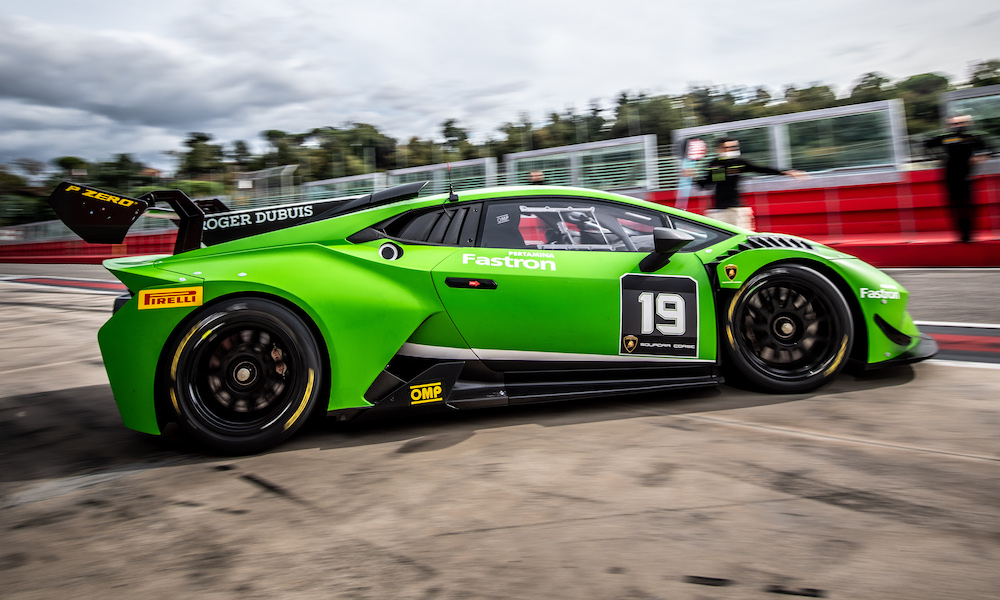
Photo: Lamborghini
Imola. 10 a.m. Early October.
The locals’ quiet mornings are interrupted by the familiar thrum of a 620 horsepower Italian race car warming up in of the garages of the Autodromo Internazionale Enzo e Dino Ferrari.
A short while later, the first of three drivers clad in Squadra Corsa garments clambers into the Lamborghini Super Trofeo Evo.
First out of the pits is a Huracan Evo RWD road car – the production equivalent of Lamborghini’s racing line – with a Lamborghini instructor at the wheel.
The production vehicle is swiftly followed by the Super Trofeo Evo and the warmup hum breaks into a scream, the noise rising and falling as Naujoks deftly cascades through Imola’s hilly profile and passes behind the gaps in the thick trees.
A few laps later and he’s back in the pits to give his impressions of an opportunity that only a few years ago would likely not have existed.
“I think the closest thing between a sim and the Super Trofeo is the sound,” says Naujoks, who gets straight into the comparisons.
“You just immediately know when to shift without looking at the lights on the display. The sim’s really accurate, so that gave me a familiar feeling. And in terms of graphics, I can’t complain there!
“In a few corners I was really tapping into it and it did feel similar. The car is giving you way more information than the sim.
“When the tires start sliding you feel that through the whole chassis, whereas in the game you just have it through the audio, the wheel and a tiny bit through vision.
“In the real world, it’s so much richer.”
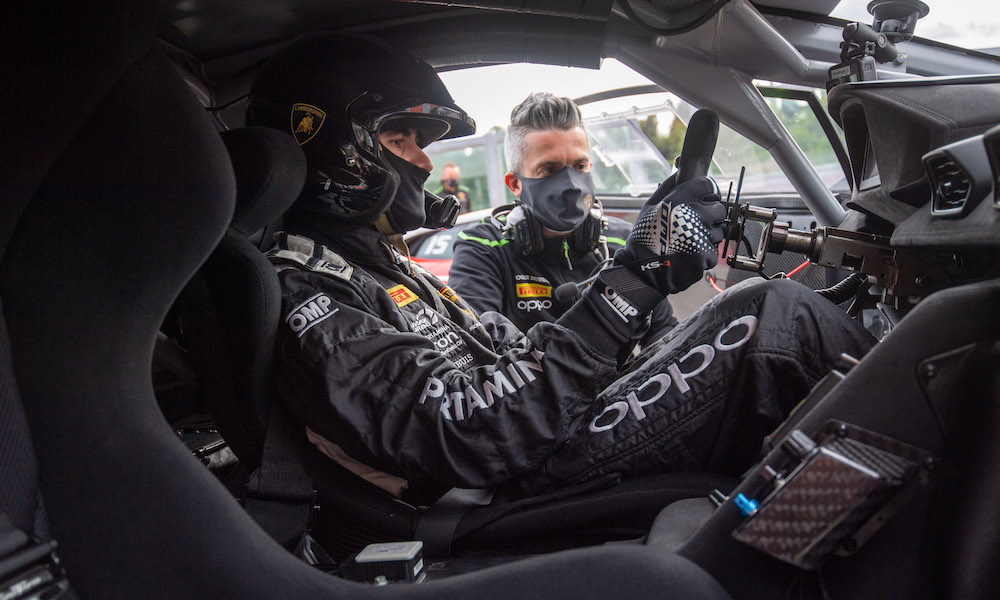
Photo: Lamborghini
Naujoks, clearly elated by the experience, sits back to process what he’s just done as Egger and Sherratt take their turns behind the wheel of the powerful single-make racer.
There are smiles all-round as the esports winners rotate through their prize program, which also includes laps in the road cars and an esports timed shootout.
Invited guests also take turns to try out both virtual and real Lamborghini models at speed.
It’s a chance to understand where the sim racers are coming from: from lapping in a road car and experiencing the Super Trofeo Evo from the passenger’s seat, it’s easy to grasp just how closely intertwined sim racing and real-world performance driving are.
Virtual racing obviously isn’t as visceral, as chaotic as the real thing. And you don’t pay any real price if you get it wrong on the game.
But there is plenty of evidence that sim racing quickens a driver’s adaptation to the real cockpit.
It’s striking how similar the reaction times, throttle application and car positioning need to be across the two environments for one’s driving to be effective in both settings.
“It was cool to go from the game to the car,” says Sherratt after his run-out.
“There were a few things, in terms of steering and brakes, that were pretty similar to the game. It meant that we could adapt quickly.
“It’s much easier when you do the game and come to the actual car. It becomes so natural because you’ve been doing it for so long on the sim.
“I felt synchronized with the car instantly.”
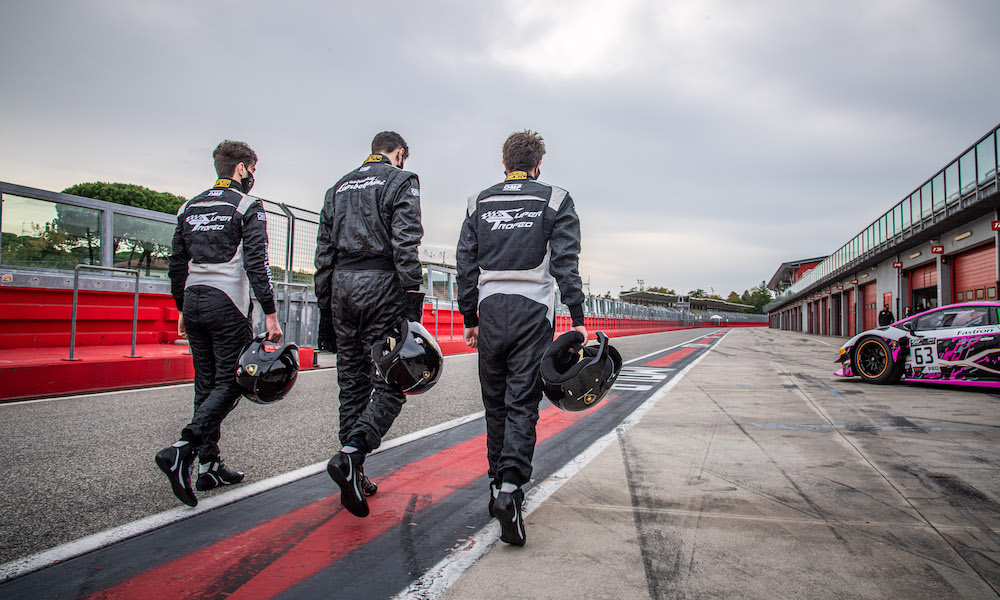
Photo: Lamborghini
Re-Opening Closed Doors
Sherratt couldn’t have returned to the wheel of a racing car without his brother.
A few years ago the former open-wheel driver, whose motorsport career went no further than the 2017 season, was introduced to Assetto Corsa Competizione by his sibling who just wanted him to have a go for fun.
A few laps later and the racing instinct had kicked back in, and Sherratt – who’s currently studying construction management at university – was hooked.
Little did he know that the fun races he was participating in with a community of fellow South African sim enthusiasts would be the start of a journey taking him to Imola for a test in a Super Trofeo Evo.
Sherratt’s success on the national sim racing scene led to appearances at progressively higher rungs of competition before he caught wind of Lamborghini’s The Real Race.
“If you go back 10 years, who would have thought there would be any esports like this,” says Sherratt, who hadn’t driven a race car in three years until his Lamborghini call-up.
“It provides a lot of opportunities for guys like myself, who would like a second chance of perhaps getting some way into racing, whether it’s esports or if they do a proper program from virtual to real car.
“That’s exactly what we did, and I think it was an amazing opportunity. It’s almost a once-in-a-lifetime opportunity because not a lot of people get it. For me, it’s incredible.”
Sherratt hopes his experience can open doors for the future, and perhaps even facilitate a return to motorsport for a driver who once traded paint with the likes of rising open-wheel star Kyle Kirkwood and IMSA Prototype Challenge champion Austin McCusker.
“I guess I’m quite a good example now, being in the shadow of the real Lamborghini team and just being seen,” he says.
“That’s the biggest thing, getting yourself out there. Having Lamborghini behind this is quite cool, and who knows what they will do with this in the future.”
Lamborghini certainly views The Real Race as a success with this year’s strong uptake of Assetto Corsa Competizione talent highlighting the global interest in the concept.
The manufacturer can be expected to build on what it achieved during the recent motorsport shutdown heading into next year and beyond.
What’s clear from Lamborghini’s 2020 pilot project is that racing brands are taking esports more seriously than ever before and noticing the massive potential benefits of sim racing in terms of marketability and investing in previously unnoticed talent.
Recent global events have only quickened the pace at which esports is being harnessed by motorsport’s big players, leaving space for a grand co-operative future ahead.
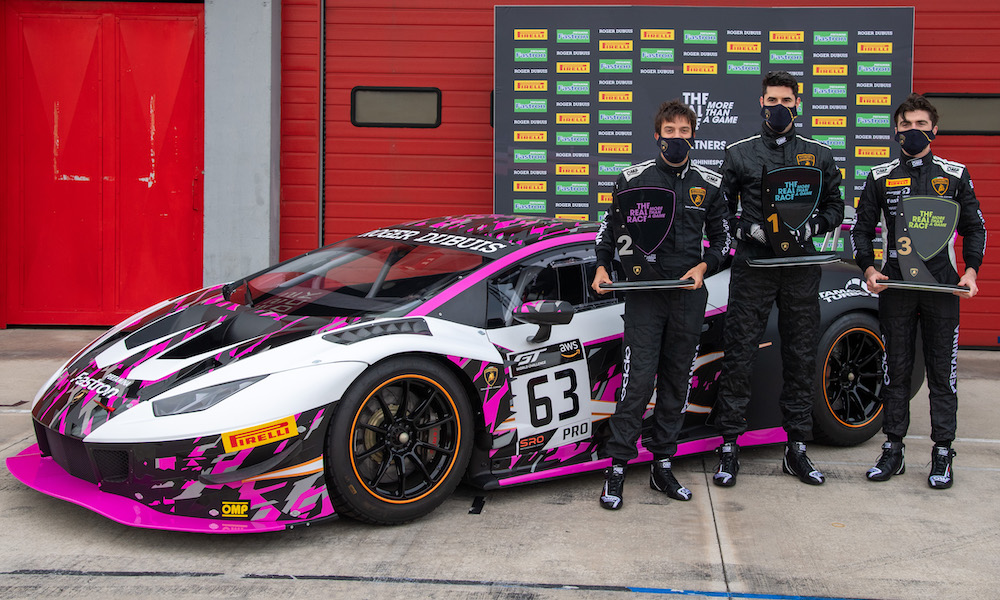
Photo: Lamborghini




















